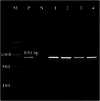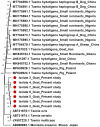Prevalence and phylogeography of Taenia hydatigena metacestodes from goats of India
- PMID: 35570666
- PMCID: PMC11010500
- DOI: 10.1017/S0031182022000713
Prevalence and phylogeography of Taenia hydatigena metacestodes from goats of India
Abstract
The study determined the prevalence and genetic population structure relationships of Cysticercus tenuicollis (Taenia hydatigena metacestode) retrieved from the goats slaughtered in north India. An overall prevalence of 9.62% (59/613) was recorded. Genetic population structure relationships were assessed by targeting partial cytochrome c oxidase subunit 1 mitochondrial gene sequence. Phylogenetic tree analysis revealed that all the present study representative isolates (n = 7) formed a major clade and grouped with T. hydatigena isolates retrieved from sheep, goats, pigs and dogs, originating from China, Iran, Nigeria, Ghana and Poland. However, a single isolate from Himachal Pradesh (isolate 3) formed a subgroup within the clade. The neutrality and diversity indices revealed high values of haplotype diversity [Hd = 0.99695 (0.95238–1.0000)] and low nucleotide diversity (π = 0.49276), which was indicative of demographic expansion and low gene flow, suggesting that Indian T. hydatigena isolates were not genetically differentiated. Tajima's D (−1.26988) and Fu and Li's D statistics values (−0.74556) were negative, demonstrating deviations from neutrality and both propounded recent population expansion or purifying selection. Results highlighted a low genetic diversity of T. hydatigena metacestodes across the geographical range of north India.
Keywords: Cysticercus tenuicollis; cytochrome c oxidase subunit 1 gene; genetic variation; phylogeography.
Conflict of interest statement
None.
Figures






Similar articles
-
Genetic diversity of Taenia hydatigena in the northern part of the West Bank, Palestine as determined by mitochondrial DNA sequences.Acta Parasitol. 2018 Jun 26;63(2):299-303. doi: 10.1515/ap-2018-0034. Acta Parasitol. 2018. PMID: 29654682
-
Preliminary information on the prevalence and molecular description of Taenia hydatigena isolates in Pakistan based on mitochondrial cox1 gene.Infect Genet Evol. 2020 Nov;85:104481. doi: 10.1016/j.meegid.2020.104481. Epub 2020 Jul 28. Infect Genet Evol. 2020. PMID: 32736043
-
Leading report regarding the molecular epidemiology of Taenia hydatigena from Pakistan and global overview of the genetic diversity and population structure of the parasite.Comp Immunol Microbiol Infect Dis. 2024 Nov;114:102248. doi: 10.1016/j.cimid.2024.102248. Epub 2024 Oct 1. Comp Immunol Microbiol Infect Dis. 2024. PMID: 39378535
-
Molecular characterization of Cysticercus tenuicollis isolates from sheep in the Nile Delta, Egypt and a review on Taenia hydatigena infections worldwide.Parasitology. 2021 Jul;148(8):913-933. doi: 10.1017/S0031182021000536. Epub 2021 Mar 29. Parasitology. 2021. PMID: 33775267 Free PMC article.
-
Assessment of the global pattern of genetic diversity in Echinococcus multilocularis inferred by mitochondrial DNA sequences.Vet Parasitol. 2018 Oct 15;262:30-41. doi: 10.1016/j.vetpar.2018.09.013. Epub 2018 Sep 27. Vet Parasitol. 2018. PMID: 30389009 Review.
Cited by
-
Genetic structure and evolutionary dynamics of Babesia gibsoni populations: a cytochrome oxidase subunit I (COXI) gene-based study.BMC Vet Res. 2025 Jul 26;21(1):492. doi: 10.1186/s12917-025-04947-x. BMC Vet Res. 2025. PMID: 40713612 Free PMC article.
-
First Insight into the Phylogenetic Diversity of Bovicola caprae Infesting Goats of Different Agro-climatic Locations in India.Biochem Genet. 2025 Aug;63(4):3465-3478. doi: 10.1007/s10528-024-10886-3. Epub 2024 Jul 13. Biochem Genet. 2025. PMID: 39003435
-
Population genetics of Babesia vogeli based on the mitochondrial cytochrome b gene.Sci Rep. 2024 Sep 20;14(1):21975. doi: 10.1038/s41598-024-72572-z. Sci Rep. 2024. PMID: 39304683 Free PMC article.
-
Visceral cysticercosis in a Kunekune sow: description and molecular identification of Taenia hydatigena.Helminthologia. 2024 Jul 16;61(2):201-204. doi: 10.2478/helm-2024-0017. eCollection 2024 Jun. Helminthologia. 2024. PMID: 39040802 Free PMC article.
-
First Molecular Confirmed Outbreak of Malignant Ovine Theileriosis in Sheep from North India.Acta Parasitol. 2023 Sep;68(3):527-534. doi: 10.1007/s11686-023-00684-z. Epub 2023 Jun 17. Acta Parasitol. 2023. PMID: 37328625
References
-
- Adwan K, Jayousi A, Abuseir S, Abbasi I, Adwan G and Jarrar N (2018) Genetic diversity of Taenia hydatigena in the northern part of the West Bank, Palestine as determined by mitochondrial DNA sequences. Acta Parasitologica 63, 299–303. - PubMed
-
- Bandelt H, Forster P and Röhl A (1999) Median-joining networks for inferring intraspecific phylogenies. Molecular Biology and Evolution 16, 37–48. - PubMed
-
- Boufana B, Scala A, Lahmar S, Pointing S, Craig PS, Dessì G, Zidda A, Pipia AP and Varcasia A (2015) A preliminary investigation into the genetic variation and population structure of Taenia hydatigena from Sardinia, Italy. Veterinary Parasitology 214, 67–74. - PubMed
-
- Bowles J, Blair D and McManus DP (1992) Genetic variants within the genus Echinococcus identified by mitochondrial DNA sequencing. Molecular and Biochemical Parasitology 54, 165–173. - PubMed
MeSH terms
LinkOut - more resources
Full Text Sources
Research Materials
Miscellaneous

